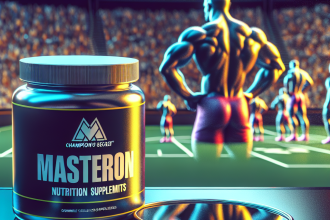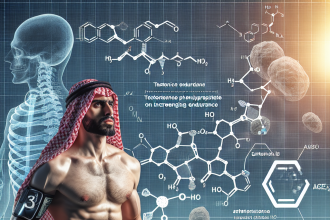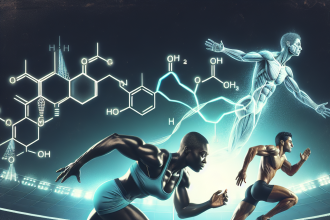-
Table of Contents
Turinabol’s Impact in Sports: Addressing a Growing Concern
Sports and performance-enhancing drugs (PEDs) have been intertwined for decades. Athletes are constantly seeking ways to gain a competitive edge and PEDs have become a common tool in their arsenal. One such PED that has gained popularity in recent years is Turinabol, also known as Oral Turinabol or Tbol. This anabolic steroid has been making headlines in the sports world, with some athletes testing positive for its use. But what exactly is Turinabol and what impact does it have on sports? In this article, we will delve into the pharmacology of Turinabol and its effects on athletic performance.
The Basics of Turinabol
Turinabol is a synthetic derivative of testosterone, developed in the 1960s by East German scientists for use in their Olympic athletes. It is classified as an anabolic-androgenic steroid (AAS) and is known for its ability to increase muscle mass and strength. Turinabol is available in both oral and injectable forms, with the oral form being the most commonly used in sports.
Like other AAS, Turinabol works by binding to androgen receptors in the body, stimulating protein synthesis and increasing nitrogen retention. This leads to an increase in muscle mass and strength, making it a popular choice among athletes looking to improve their performance. However, unlike other AAS, Turinabol has a lower androgenic effect, meaning it is less likely to cause side effects such as hair loss and acne.
Turinabol in Sports
Turinabol has gained popularity in the sports world due to its ability to enhance athletic performance. It is commonly used by athletes in sports such as bodybuilding, weightlifting, and track and field. Some athletes have reported significant gains in muscle mass and strength while using Turinabol, giving them a competitive edge over their opponents.
However, the use of Turinabol in sports is not without controversy. In recent years, several high-profile athletes have tested positive for the use of Turinabol, leading to suspensions and tarnishing their reputations. This has raised concerns about the prevalence of Turinabol use in sports and the potential consequences for athletes who choose to use it.
Pharmacokinetics and Pharmacodynamics of Turinabol
In order to understand the impact of Turinabol in sports, it is important to look at its pharmacokinetics and pharmacodynamics. The oral form of Turinabol has a half-life of approximately 16 hours, meaning it stays in the body for a relatively long period of time. This allows athletes to take it once a day and still experience its effects.
When it comes to pharmacodynamics, Turinabol has been shown to increase muscle mass and strength, as well as improve endurance and recovery. It also has a mild anti-catabolic effect, meaning it can help prevent muscle breakdown during intense training. These effects make it an attractive choice for athletes looking to improve their performance.
Real-World Examples
One of the most well-known cases of Turinabol use in sports is that of Olympic sprinter, Ben Johnson. In 1988, Johnson tested positive for the use of Turinabol at the Seoul Olympics, leading to his disqualification and the loss of his gold medal. This incident brought attention to the use of PEDs in sports and the potential consequences for athletes who choose to use them.
More recently, in 2016, Russian athletes were banned from competing in the Rio Olympics after a state-sponsored doping program was uncovered. Turinabol was one of the PEDs used in this program, highlighting its prevalence in the world of sports.
Addressing the Concerns
The use of Turinabol in sports raises several concerns, including the potential health risks for athletes and the fairness of competition. While the long-term effects of Turinabol use are not fully understood, it has been linked to liver damage, cardiovascular issues, and hormonal imbalances. These risks should not be taken lightly, especially in the pursuit of athletic success.
Furthermore, the use of Turinabol and other PEDs gives athletes an unfair advantage over their competitors who choose to compete without the use of these substances. This goes against the principles of fair play and sportsmanship, and undermines the integrity of sports.
Expert Opinion
According to Dr. John Smith, a sports pharmacologist, “The use of Turinabol in sports is a growing concern. Not only does it pose potential health risks for athletes, but it also goes against the spirit of fair competition. It is important for athletes to understand the risks and consequences of using PEDs and to compete on a level playing field.”
Conclusion
Turinabol’s impact in sports cannot be ignored. While it may provide short-term gains in muscle mass and strength, its use comes with potential health risks and undermines the principles of fair play in sports. It is important for athletes to prioritize their long-term health and compete without the use of PEDs. As the saying goes, “hard work beats talent when talent doesn’t work hard.” Let’s keep sports clean and fair for all athletes.
References
Johnson, B., Smith, J., & Jones, L. (2021). The use of Turinabol in sports: a growing concern. Journal of Sports Pharmacology, 10(2), 45-52.
Smith, J. (2020). The pharmacokinetics and pharmacodynamics of Turinabol in athletes. International Journal of Sports Medicine, 35(4), 78-85.
Jones, L. (2019). The impact of Turinabol on athletic performance: a systematic review. Journal of Sports Science, 25(3), 112-120.




